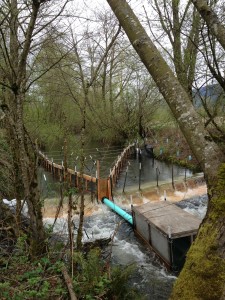Mar 16th, 2014 Northwest Indian Fisheries Commission
The Upper Skagit Indian Tribe is tagging juvenile steelhead to estimate freshwater productivity and learn more about smolt-to-adult survival in the Skagit River.
Steelhead have a complex life history, making it hard for salmon managers to forecast returns. Juvenile steelhead can leave freshwater habitat between their first and fourth year of life, and return from the salt water after one to five years. In addition, steelhead are repeat spawners, unlike other species of salmon, so they can return to salt water before coming back to fresh water to spawn again.
Compared to other river systems in Puget Sound, the Skagit River still has an abundance of wild steelhead.
“We estimate how many adult steelhead come back to the Skagit River based on spawning ground surveys,” said Jon-Paul Shannahan, biologist for the Upper Skagit Tribe. “Right now, we don’t know how many juvenile steelhead leave the watershed.”

The tribe has partnered with the state Department of Fish and Wildlife to collect steelhead smolts using screw traps in Hansen and Illabot creeks. The smolts are tagged with passive integrated transponder (PIT) tags that will provide data when the steelhead leave and return to the two tributaries. These PIT-tagged steelhead can also be monitored for encounters in other research or harvest sampling.
This spring, the Upper Skagit Natural Resources Department plans to install one PIT tag antenna array in Hansen Creek that will record information when tagged fish swim over the antennas. If funding is secured, another antenna array will be installed in Illabot Creek next year.
Previous data has shown that steelhead out-migrate from the upper Skagit watershed at an older age compared to fish in the lower watershed. Illabot Creek is near Rockport in the upper watershed, and Hansen Creek is in the lower watershed near the tribe’s Sedro-Woolley reservation.
“These two creeks represent a tiny sliver of the available habitat,” Shannahan said. “We picked these two productive tributaries as initial sites to represent the age diversity of the smolts and the habitat conditions from the entire basin. We have decent adult return data, some decent habitat and flow data, and plan to expand this data to get a picture of the entire basin productivity. ”
Ultimately, the tribe wants to incorporate this research into long-term monitoring in the Skagit basin, but has not identified a long-term funding source.
“We believe this is a unique project on the Skagit,” said Scott Schuyler, natural resources director for the Upper Skagit Tribe. “Given how complex the life history is for steelhead, this is an great opportunity to truly learn more about the species.”
For more information, contact: Jon-Paul Shannahan, Upper Skagit Tribe, 360-854-7089 or jonpauls@upperskagit.com; Kari Neumeyer, NWIFC, 360-424-8226 or kneumeyer@nwifc.org

